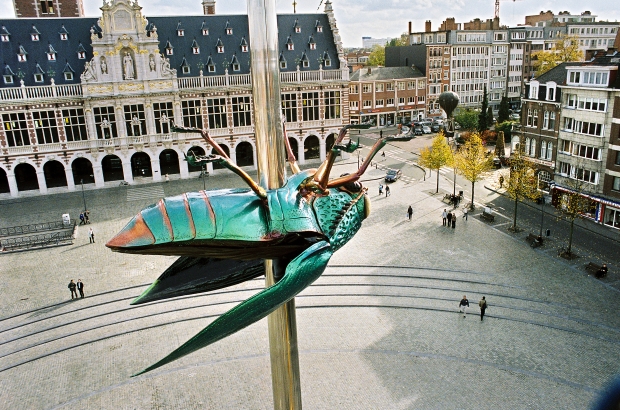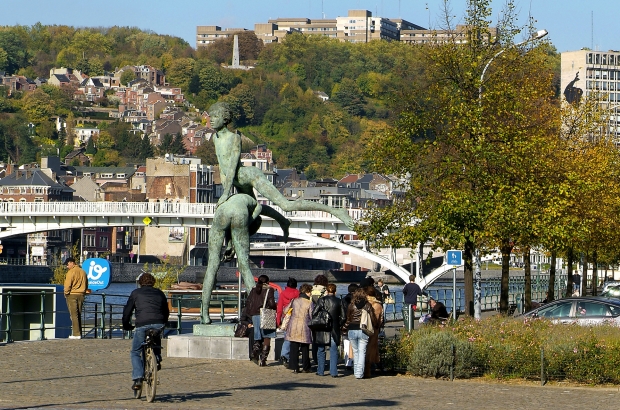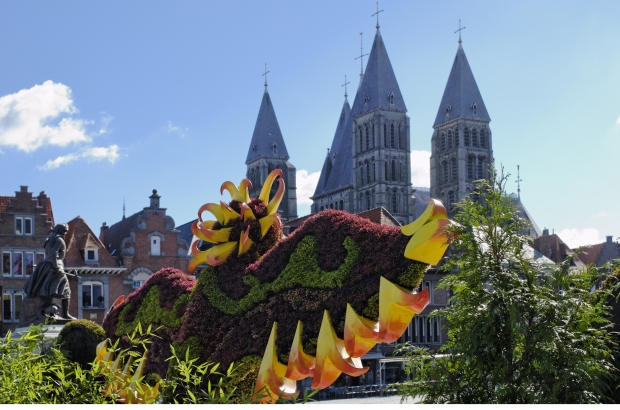- Daily & Weekly newsletters
- Buy & download The Bulletin
- Comment on our articles
Banish the holiday blues with a day out or weekend in one of these Belgian cities
BRUGES
Belgium’s famed fairy-tale city Bruges was the commercial hub of medieval Europe and it has the architecture to prove it. From the town hall to the world-famous belfry (which was arguably the real star of the 2008 British crime drama In Bruges), the city’s ancient buildings scream Old World opulence. It’s no surprise, then, that the former financial capital of Europe – now the administrative capital of West Flanders – has been successfully marketed as a prime tourist destination for more than a century. Bruges is a time capsule and visitors flock from around the world to stroll its cobblestone streets, float down its famous canals (second in renown only to those of Venice) and take in its rich history.
Sights
In a city full of spectacular sights, the most spectacular of all is the Markt. This broad, sun-drenched square is framed on all sides by gothic facades and grand terraces. This is where you’ll find the iconic Bruges belfry, too. Indeed, you can’t miss it. The thing towers 83 metres over the Markt and, if you have the stamina to climb its 366 steps, it offers a breathtaking aerial view of Bruges. The recently opened Historium interactive visitor centre offers an immersive trip back in time, but the city is well enough preserved that a high-tech simulation isn’t the only way to get a fix of old Bruges. It’s everywhere. One particularly fine spot for a promenade is the Begijnhof, a leafy religious sanctuary well within the old town. The Benedictine redoubt is still used by nuns of the order, who you may spot going about their daily business on the grounds.
Culture
Bruges is full of museums, but the city’s flagship institution is the Groeninge museum, home to an impressive collection of Flemish Primitives including the seminal Bruges resident Jan van Eyck. It also showcases more recent works from the 19th and 20th centuries. Music-lovers will be pleased to discover the Concertgebouw. The ultra-modern performing arts centre hosts international classical and contemporary artists as well as well as pop, rock and world music.
Food
Dining in holiday hotspots is always a hit-or-miss affair so beware of tourist traps. The Markt’s fritkots are perennial favourites. If you’re in the mood for something more than a snack, the Olive Tree is just a stone’s throw from the main square and serves up delicious Greek cuisine. Or go native and eat at one of the many restaurants on ’T Zand, at the edge of the old town. GV
LEUVEN
There’s a reason why Fonske has a book in one hand and a beer in the other. The full name of the little statue standing right in front of the monumental Saint-Peter’s church is Fons Sapientiae, Latin for ‘source of wisdom. Fonske represents a student at the largest and oldest university of the Low Countries, the University of Leuven, merging the wisdom of books with the delight of beer. Welcome to Leuven, thirsty for knowledge and more.
See
It may be a bit smaller but it’s just as impressing as its Brussels counterpart: no visitor can ignore the gothic grandeur of the Town Hall, built between 1448 and 1469 and updated in the 19th century with 236 little statues representing local historical figures and patron saints. It was one of the few old buildings that resisted both World Wars. From the roof of Museum M, which is worth a visit for its well-balanced mix of old masters and contemporary art, you get the best view of the other landmark building, the university’s Central Library. After the ravage of war – in which a lot of books were burned – it was rebuilt and restocked with the financial support from the Americans, as you can read from the inscriptions on the stones. The polyester scarab on a 75-foot high steel needle on the square in front of the library was created by artist Jan Fabre.
Hear
Well, now you might as well catch a chimes concert. The 63 clocks of the carillon, housed in the tower of the university library, weigh 35 tons, making it the second heaviest in the country. Every 15 minutes you can hear a short time sign, based on the traditional Flemish song Reuzegom. During the academic year, there’s a performance every Tuesday and Thursday from 19.00 to 19.45. In summer, all the carillon concerts are presented as Leuven Bells, with thematic evenings at M’s rooftop terrace and in the picturesque Unesco-protected béguinage. For a more contemporary musical experience head towards concert hall Het Depot, a renovated cinema hall offering the best quality in sound for your musical night outs. Do try an emerging Belgian band at one of their free foyer concerts.
Walk
Another option is taking a short walk to Opek, a former customs warehouse turned into an arts centre and the base of the excellent local music theatre company Braakland/Zhebilding. On your way you get to see the Stella Artois brewery and the small marina, at the end of the Mechelen-Leuven canal. Nipping from a drink in the relaxed Café Entrepot, you might consider a walk to Park Abbaye, which is bound to become a big museum for religious art. It surely is one of the hidden gems of the area, offering countryside calmness, including cows, cornfields and ponds, all within walking distance from the city.
Drink/eat/sleep
Entering the city from Brussels by train you probably noticed (and maybe even smelled) the reason the place is known worldwide: Stella Artois is brewed here. With the ‘longest bar in the world’ – that’s what locals call the lively pubs around the Oude Markt square – it’s no surprise the city’s hotels offer special beer arrangements. According to your budget your options run from staying overnight in De Blauwput youth hostel to a more pricey residence in Begijnhof Hotel or Martin’s Klooster, four-star accommodations in local heritage. Still thirsty? Try a house-brewed Con Domus or Nostra Domus in the brasserie of the same name. Check out De Dry Coppen for the combination of coffee and books, the cosy De Blauwe Kater for blues and beers, De Werf for their colourful summer terrace and STUKcafé for drinks before and after visiting the cultural centre and future ‘house for dance, image and sound’. TP
LIEGE
It’s nicknamed the ardent city, and you need to study the history of Liège to understand its fierce independent spirit. The once industrial powerhouse of Belgium was for 800 years a separate principality. Ruled by a prince-bishop prince until the end of the 18th century, it was the only part of Belgium to escape successive foreign rule. Today, the largest city in Wallonia is a cultural beacon of art, design and fashion. It also continues to look outwards, and in the 21st century, Liège is rebranding itself as an international metropolis.
Transport
Lying on the river Meuse, Liège has become a major transport hub and is part of the influential cross-border economic Meuse-Rhine Euroregion. Liège Airport is just outside the city and the Santiago Calatrava-designed Guillemins station places Liège at the centre of a European high-speed network. When driving out of the city, the massive soaring structure is an impressive sight. Be warned, a new tram line, planned for 2018, is currently transforming the city into a major building site.
Folklore
Liège is home to numerous folklore traditions. For a full appreciation of the depth of Walloon culture, don’t miss the Museum of Walloon Life, near Place Saint-Lambert (if you’re feeling energetic, climb the narrow steps behind the museum to the slopes of the Citadel above). It pays special attention to puppet theatre; the city’s emblem is the character Tchatchès. The puppet has pride of place in the four-day festivities that take place in mid-August in the Outremeuse area. As the most francophone city in the country, Liège celebrates the French national holiday on July 14.
See
Overlooking Place Saint-Lambert in the heart of Liège is the sumptuous prince-bishops’ palace, housing provincial offices and the law courts. Guided tours are available, or you can walk through the main entrance to marvel at the medieval courtyard. Heading east, the museum quarter includes the refurbished Curtius museum, dedicated to history and art. The area includes the city’s oldest religious building, the Collegiate Church of Saint-Barthélemy. Cross the river by Pont des Arches, the favoured bridge of local crime writer Georges Simenon, and explore the Outremeuse area. The commercial centre, known as the Carré, is a warren of enticing shops, and its bars are popular student haunts at night. Shopaholics can head to the Médiacité complex, which includes an ice skating rink, open all year round. Take a tourist train from the centre to see all the city sights.
Eat/drink/sleep
A local speciality is boulets de Liège, savoury meatballs in a Liège syrup sauce. One authentic restaurant serving them is Chez Lequet. For an introduction to pèkèt, the local genever made from juniper berries, go to La Maison du peket, which proposes 30 flavours. Other regional favourites are boudin sausages and sugar-encrusted Liège waffles. Italian immigration has influenced local cuisine and pizza and pasta joints abound. In the foyer of the newly opened Wallonia Royal Opera House, enjoy a quick self-service lunch in a grandiose setting. Equally fabulous is the five-star Crowne Plaza Hotel, a modern complex created out of two elegant townhouses. Smaller but still stylish is the Hotel Neuvice, near the Place du Marché. The 18th-century building is in a street that dates from the 12th century and today has an excellent choice of high-quality food shops. SC
TOURNAI
It may be frequently overlooked, but Tournai is a historical gem, with its gentle pace and healthy appetite for local brews and festivities. Known for its artistic background – porcelain, tapestry, antiques – as well as its history, the city is part of the economic and cultural hub known as the Eurometropolis that incorporates Lille in northern France and Kortrijk in West Flanders.
History
The oldest city in Belgium after Tongeren and Arlon, Tournai is the only city to have been conquered by the English. Henry VIII captured it in 1513; despite the fortress city’s beefed-up defences, France reclaimed it in 1519. The Henry VIII Tower is a hefty reminder of the British presence: the large circular monument sits incongruously in a square of fine bourgeois homes. Founded by the Romans as a transport link on the river Scheldt, Tournai’s illustrious history continued in the fifth century when it was conquered by the Frankish tribes and became the Merovingian capital. It then flourished in the 11th century when it became the religious centre of Flanders and a key trade route.
See
The towering landmark of this eminent past is the World Heritage status Notre-Dame cathedral, with its five bell towers bisecting a Romanesque nave and Gothic choir. Scaffolding shrouds much of the cathedral as the latest in a long line of renovation projects repairs the ravages of time. The triangular Grand Place nearby has been fully restored since the 1940 bombardment and its majestic Cloth Hall remains from the once-prosperous medieval wool trade. Overlooking the square and adding to Sunday morning’s carillon peal is the 70-metre 1217 belfry. Tournai’s other emblematic vestige is the romantic 13th-century Pont des Trous, a fortified water bridge. The museum quarter around the elegant and landscaped town hall includes the Musée des Beaux-Arts, designed by Victor Horta in an Art Nouveau style.
Walk
The walled city, intersected by the river, is ideal for walking. Wander with little risk of getting lost: signposts and the looming cathedral towers are sufficient navigational aids. From the centre, cross the river where barges still ply their trade, and meander through ancient streets of Roman houses and handsome squares and town houses. There are reminders, though, that Tournai, like much of Hainaut province, is still climbing out of a post-industrial slump; gentrification is not widespread and the city is a fascinating hotchpotch of medieval cobbles, run-down timbered houses, building sites and kebab shops.
Drink/eat/sleep
Overlooking the river lie the former fish market and a row of bars that liven up at night. A favourite is La Vie des Belges, offering regional tapas and tipples. Sampling local beers is recommended. Look out for the following breweries: Brunehaut, Dubuisson (Bush, Troll), Bon Secours, Saint-Feuillien, Saint-Martin and Le Tournay. North African eateries and brasseries abound; one gourmet option on the quayside for couscous and tagine is D’Olive et de menthe. For places to stay, the three-starred Cathedral Hotel has a prime location in Place Saint-Pierre, but the boutique Alcantara Hotel, tucked behind the Grand Place, is a quieter alternative. For edible souvenirs, head to Quesnoy Patisserie by the station for Clovis cake (named after the Merovingian king), a solid frangipane and apricot jam confection, or try apricot-flavoured iced biscuits called palets de dame or the hard black sweets known as ballons de Tournai. SC





















